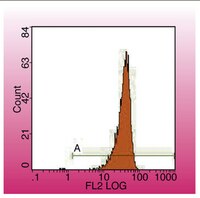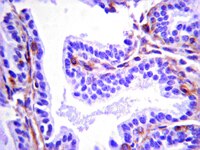Merkel Cell Polyomavirus Small T Antigen Induces Cancer and Embryonic Merkel Cell Proliferation in a Transgenic Mouse Model.
Shuda, M; Guastafierro, A; Geng, X; Shuda, Y; Ostrowski, SM; Lukianov, S; Jenkins, FJ; Honda, K; Maricich, SM; Moore, PS; Chang, Y
PloS one
10
e0142329
2015
Show Abstract
Merkel cell polyomavirus (MCV) causes the majority of human Merkel cell carcinomas (MCC) and encodes a small T (sT) antigen that transforms immortalized rodent fibroblasts in vitro. To develop a mouse model for MCV sT-induced carcinogenesis, we generated transgenic mice with a flox-stop-flox MCV sT sequence homologously recombined at the ROSA locus (ROSAsT), allowing Cre-mediated, conditional MCV sT expression. Standard tamoxifen (TMX) administration to adult UbcCreERT2; ROSAsT mice, in which Cre is ubiquitously expressed, resulted in MCV sT expression in multiple organs that was uniformly lethal within 5 days. Conversely, most adult UbcCreERT2; ROSAsT mice survived low-dose tamoxifen administration but developed ear lobe dermal hyperkeratosis and hypergranulosis. Simultaneous MCV sT expression and conditional homozygous p53 deletion generated multi-focal, poorly-differentiated, highly anaplastic tumors in the spleens and livers of mice after 60 days of TMX treatment. Mouse embryonic fibroblasts from these mice induced to express MCV sT exhibited anchorage-independent cell growth. To examine Merkel cell pathology, MCV sT expression was also induced during mid-embryogenesis in Merkel cells of Atoh1CreERT2/+; ROSAsT mice, which lead to significantly increased Merkel cell numbers in touch domes at late embryonic ages that normalized postnatally. Tamoxifen administration to adult Atoh1CreERT2/+; ROSAsT and Atoh1CreERT2/+; ROSAsT; p53flox/flox mice had no effects on Merkel cell numbers and did not induce tumor formation. Taken together, these results show that MCV sT stimulates progenitor Merkel cell proliferation in embryonic mice and is a bona fide viral oncoprotein that induces full cancer cell transformation in the p53-null setting. | 26544690
 |
Impaired autophagy contributes to adverse cardiac remodeling in acute myocardial infarction.
Wu, X; He, L; Chen, F; He, X; Cai, Y; Zhang, G; Yi, Q; He, M; Luo, J
PloS one
9
e112891
2014
Show Abstract
Autophagy is activated in ischemic heart diseases, but its dynamics and functional roles remain unclear and controversial. In this study, we investigated the dynamics and role of autophagy and the mechanism(s), if any, during postinfarction cardiac remodeling.Acute myocardial infarction (AMI) was induced by ligating left anterior descending (LAD) coronary artery. Autophagy was found to be induced sharply 12-24 hours after surgery by testing LC3 modification and Electron microscopy. P62 degradation in the infarct border zone was increased from day 0.5 to day 3, and however, decreased from day 5 until day 21 after LAD ligation. These results indicated that autophagy was induced in the acute phase of AMI, and however, impaired in the latter phase of AMI. To investigate the significance of the impaired autophagy in the latter phase of AMI, we treated the mice with Rapamycin (an autophagy enhancer, 2.0 mg/kg/day) or 3-methyladenine (3MA, an autophagy inhibitor, 15 mg/kg/day) one day after LAD ligation until the end of experiment. The results showed that Rapamycin attenuated, while 3MA exacerbated, postinfarction cardiac remodeling and dysfunction respectively. In addition, Rapamycin protected the H9C2 cells against oxygen glucose deprivation in vitro. Specifically, we found that Rapamycin attenuated NFκB activation after LAD ligation. And the inflammatory response in the acute stage of AMI was significantly restrained with Rapamycin treatment. In vitro, inhibition of NFκB restored autophagy in a negative reflex.Sustained myocardial ischemia impairs cardiomyocyte autophagy, which is an essential mechanism that protects against adverse cardiac remodeling. Augmenting autophagy could be a therapeutic strategy for acute myocardial infarction. | 25409294
 |
Oxidative stress, inflammation, and autophagic stress as the key mechanisms of premature age-related hearing loss in SAMP8 mouse Cochlea.
Menardo, Julien, et al.
Antioxid. Redox Signal., 16: 263-74 (2012)
2012
Show Abstract
AIMS: In our aging society, age-related hearing loss (ARHL) or presbycusis is increasingly important. Here, we study the mechanism of ARHL using the senescence-accelerated mouse prone 8 (SAMP8) which is a useful model to probe the effects of aging on biological processes. RESULTS: We found that the SAMP8 strain displays premature hearing loss and cochlear degeneration recapitulating the processes observed in human presbycusis (i.e., strial, sensory, and neural degeneration). The molecular mechanisms associated with premature ARHL in SAMP8 mice involve oxidative stress, altered levels of antioxidant enzymes, and decreased activity of Complexes I, II, and IV, which in turn lead to chronic inflammation and triggering of apoptotic cell death pathways. In addition, spiral ganglion neurons (SGNs) also undergo autophagic stress and accumulated lipofuscin. INNOVATION AND CONCLUSION: Our results provide evidence that targeting oxidative stress, chronic inflammation, or apoptotic pathways may have therapeutic potential. Modulation of autophagy may be another strategy. The fact that autophagic stress and protein aggregation occurred specifically in SGNs also offers promising perspectives for the prevention of neural presbycusis. | 21923553
 |












